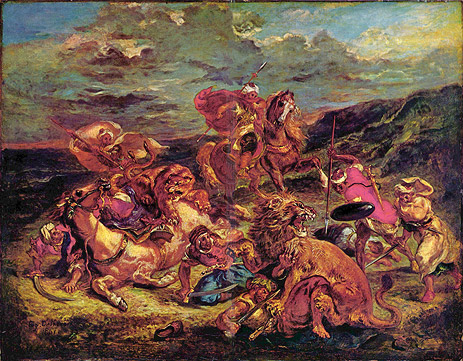Image Resource Bank
Image Gallery |  15 of 15
15 of 15 
Orientalism: The Lion Hunt
“Orientalism” is a vague label for many kinds of depiction of Eastern subjects by European and American artists, designers, writers, and scholars. Some writers and artists used the Orient as a setting in which to display passion, violence, and adventure that could not be shown in European settings. Others used Oriental settings as thin disguises for parodies and critiques of European lifeways. These kinds of “Orientalism” had ancient antecedents in literature and art of Hellenistic and Roman Europe. They had close counterparts in equally vivid “Occidentalism,” contemporary portrayals of adventure, violence, and noble savagery on the frontiers of the Americas.
As Western exploration turned toward domination through military, political, or economic influence, “Orientalist” portrayals became more vivid, more specific, but also more fraught with prejudice.
Eugène Delacroix painted Oriental subjects not long after the French conquest of Algeria made North Africa into a frontier akin to the American West. This provided Delacroix and other Romantic painters and writers with a vehicle for reacting against the balanced restraint of Neoclassical art and letters. The reaction is expressed in the alien costume and scenery of this work of Delacroix, and even more in the chaotic action, vivid color, and histrionic gesture.
This “Lion Hunt” is an unconscious variation on a theme that was rendered many times by Egyptian and Assyrian artists, whose works were discovered and made known to Europeans of the generation after Delacroix.
Name: The Lion Hunt
Material: Oil on canvas
Size:
Height: 76 cm (2 ft 5.91 in)
Width: 98 cm (3 feet 2.5 in)
Date: 1861 CE
Place of Origin: Eugène Delacroix
Location: Art Institute of Chicago, Chicago, Illinois
Source and Registration#: Wikipedia. Link to resource![]() (accessed August 17, 2009).
(accessed August 17, 2009).

 Matthew W. Stolper
Matthew W. Stolper
Professor of Assyriology and the John A. Wilson Professor of Oriental Studies




